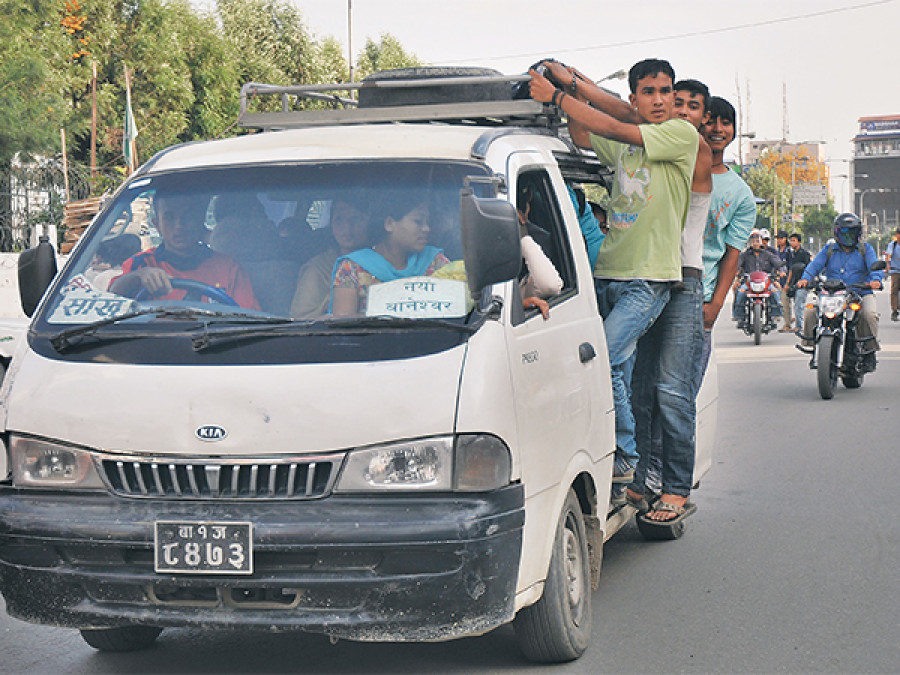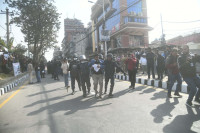Opinion
Make way
Kathmandu must develop a proper public transport system before contemplating road space rationing
Ashish Gajurel
Today, a large share of the world’s population lives in urban areas with experts estimating that the proportion of people living in urban areas will only increase in the coming years. According to the World Health Organisation, the urban population in 2014 accounted for 54 percent of the total global population, up from 34 percent in 1960. As mobility is a basic requirement for social and economic activities, the urban population is always in dire need of reliable transportation systems. Private vehicles being the most reliable means of transportation, ownership of private vehicles in cities is generally high. For instance, Kathmandu Valley accounts for around 50 percent of the total registered motorised vehicles in Nepal. But due to growing populations, which in turn lead to growing private vehicles on the road, traffic congestion becomes unavoidable in the cities.
Dealing with congestion
Traffic engineering has developed a number of strategies to alleviate this problem. Road space rationing, development of public transportation, vehicle quota system, and congestion pricing are leading strategies used worldwide to manage traffic congestion. These strategies enforce and at the same time, encourage people to shift from motorised to non-motorised vehicles or even walking. This, in turn, will subsequently help reduce fuel consumption as well. The objectives of managing road congestion are to improve traffic flow, reduce air pollution, as well as
reduce noise.
Costa Rica and Honduras have implemented rationing to reduce oil consumption. Road space rationing has been implemented in countries like Mexico, Columbia, China, Brazil, Chile, Greece, and Bolivia. During the recent 18th Saarc Summit, a road rationing programme was also implemented in Kathmandu for five days, from November 24, 2014 to November 28, 2014. Based on the odd-even number plates of vehicles, they were allowed to run on alternating days. The regulation was applied to public as well as private motorised vehicles. Reports from traffic police show that the programme was successful in reducing traffic congestion, road accidents, and air pollution. Although this strategy was applied just as a temporary solution to ease traffic flow during the Saarc Summit, discussions are ongoing at different levels to ascertain if this strategy can be applied for a greater length of time.
Odd-even number plate control is a simple mechanism to operate. According to Licence Plate Rationing Evaluation Report, the three most enduring implementation of road space rationing are in Mexico City, Mexico; Bogota, Columbia; and Sao Paulo, Brazil. The objective of this strategy is to reduce vehicle emission. In the short-term, all of these cities experienced positive results; however, the long term results were significantly different for Mexico City and Sao Paulo. Mostly, road space rationing is a temporary solution to enhance effective traffic flows.
To reduce traffic congestion and enhance smoother traffic, different countries have implemented different strategies. For instance, Sweden, England, and Singapore have implemented congestion pricing strategy to manage traffic congestion whereas countries like Columbia, Mexico, China, and Brazil have implemented rationing strategies. Currently, congestion pricing is regarded as a powerful tool to manage congestion, compared to rationing. In congestion pricing, one can pay to ply the roads, but in rationing one needs to wait for their turn.
First, public transport
Infrastructure improvement, public transportation development, encouragement to use non-motorised vehicles, road space rationing, and congestion pricing are strategies applied to manage congestion. From experience, no one single strategy has been successful in controlling congestion. Therefore, most countries have applied some combination of the aforementioned strategies. For instance, Bogota developed a Bus Rapid Transit system (BRT), in addition to using road rationing during peak hours. In London, too, a well developed public transportation system has been combined with congestion pricing. Rationing and congestion pricing mechanisms are applied only to private vehicles.
During road space rationing in Kathmandu, the regulation was applied to both private and public vehicles and priority was given to private ones over public. Such actions are against the traffic congestion management principle. Such incidents will provoke people to buy multiple cars. Public vehicles must always be prioritised over private. The aim should always be to discourage the use of private vehicles. Once people shift from private to public, traffic management will become a lot easier.
But number plate rationing must not be applied in Nepal for now. Nepal needs to adopt Bogota’s experience. First, let us develop good public transportation and then think about strategies like rationing and congestion pricing. There should be alternative means of mobility to apply such strategies.
Road space rationing will generally lead to inequity in society. It is favourable to the upper-class because they can afford two vehicles—one odd and one even. In the long run, the number of vehicles will reach a level where the demand for road space exceeds availability. There is not a single experience in the world that shows road space rationing is a solution to traffic congestion. Learning from the experience of other countries, Nepal needs to develop an automated traffic system, proper and reliable public transportation, widening of all busy roads, discourage the use of private vehicle immediately in the first phase, and only in the second phase could strategies like congestion pricing and rationing be implemented.
Gajurel is a traffic engineer ([email protected]_




 6.12°C Kathmandu
6.12°C Kathmandu










